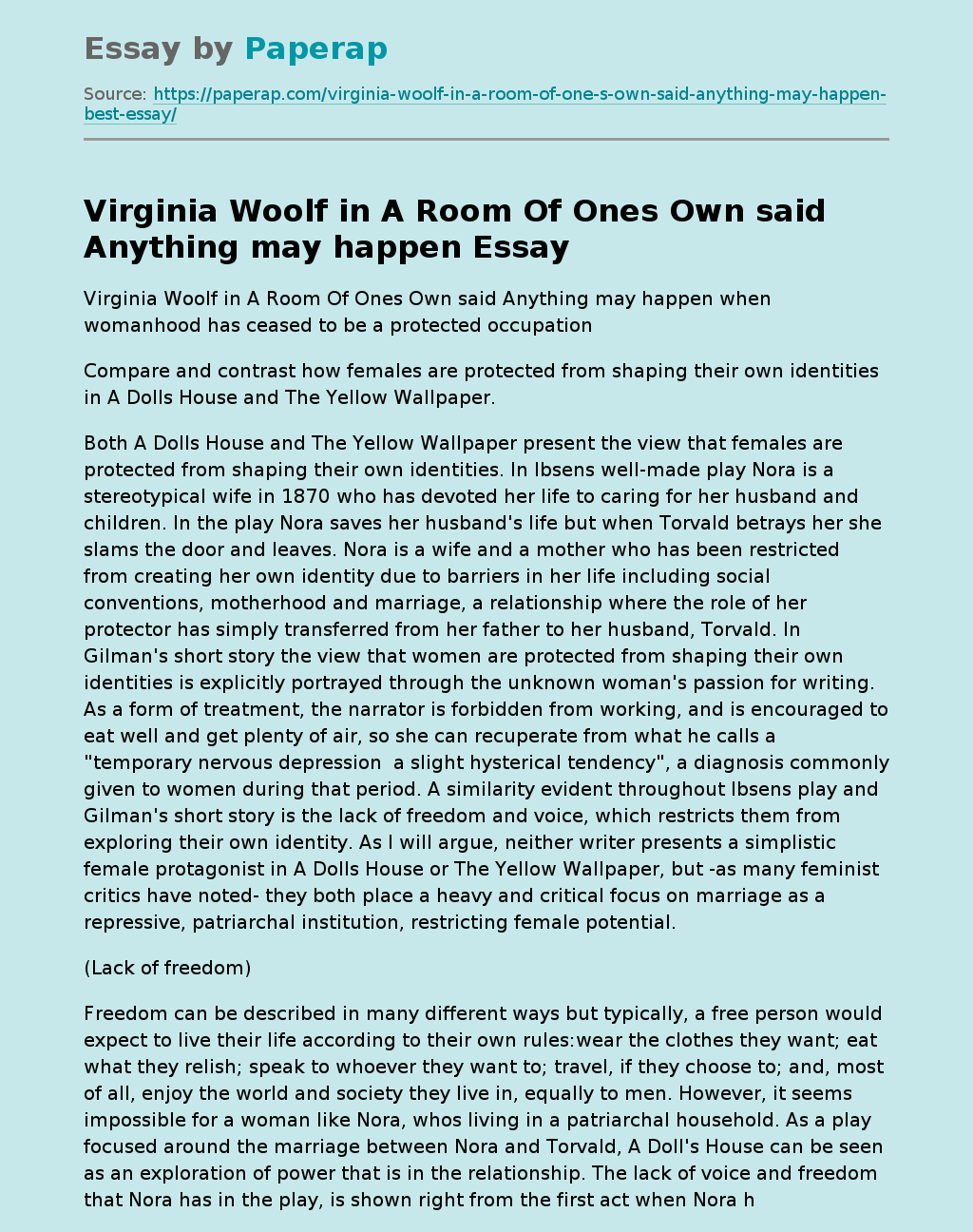Image of a Woman in Stories "Yellow Wallpaper" and "A Doll's House"
The following sample essay on Image of a Woman in Stories “Yellow Wallpaper” and “A Doll’s House” tells about a woman’s protection from forming her own personality.
Virginia Woolf in A Room Of One’s Own said “Anything may happen when womanhood has ceased to be a protected occupation”. Compare and contrast how females are protected from shaping their own identities in A Doll’s House and The Yellow Wallpaper.
Both A Doll’s House and “The Yellow Wallpaper” present the view that females are protected from shaping their own identities.
In Ibsen’s “well-made play” Nora is a stereotypical wife in 1870 who has devoted her life to caring for her husband and children. In the play Nora saves her husband’s life, but when Torvald betrays her, she slams the door and leaves. Nora is a wife and a mother who has been restricted from creating her own identity due to barriers in her life, including social conventions, motherhood and marriage, a relationship where the role of her protector has simply transferred from her father to her husband, Torvald.
In Gilman’s short story the view that women are protected from shaping their own identities is explicitly portrayed through the unknown woman’s passion for writing. As a form of treatment, the narrator is forbidden from working, and is encouraged to eat well and get plenty of air, so she can recuperate from what he calls a “temporary nervous depression a slight hysterical tendency”, a diagnosis commonly given to women during that period.
A similarity evident throughout Ibsen’s play and Gilman’s short story is the lack of freedom and voice, which restricts them from exploring their own identity. As I will argue, neither writer presents a simplistic female protagonist in A Doll’s House or The Yellow Wallpaper, but as many feminist critics have noted- they both places a heavy and critical focus on marriage as a repressive, patriarchal institution, restricting the female potential.
Lack of Freedom
Freedom can be described in many different ways, but typically, a free person would expect to live their life according to their own rules:wear the clothes they want; eat what they relish; speak to whoever they want to; travel, if they choose to; and, most of all, enjoy the world and society they live in, equally to men. However, it seems impossible for a woman like Nora, who’s living in a patriarchal household. As a play focused around the marriage between Nora and Torvald, A Doll’s House can be seen as an exploration of power that is in the relationship. The lack of voice and freedom that Nora has in the play, is shown right from the first act when Nora has to hide a trivial matter of eating macaroons. Nora’s lack of voice is evident when she tries to protect herself by justifying and hiding the truth. When she tries to convince Torvald that she would never dream of doing anything [he] didn’t want [her] to it shows to us as the audience the lack of autonomy she holds.
Also, she respects the societal belief, so much that she does not even think herself. She really tries as hard as she can to ensure that she pleases her husband while she suffers. The macaroons come to represent Nora’s lack of freedom. As expected of a typical married woman in the late 19th century Nora does not have the courage to speak against Torvald and is restricted from expressing her opinion. When she has conversations with Dr. Rank she feels much more relaxed as it is a change from the tiresome relationship with her husband.
Rank’s relationship with Nora gives us the clue into the distance that truly lies between the seemingly perfect Helmers. Nora says that her husband “used to seem almost jealous if I mentioned any of the dear folk at home, so naturally I gave up doing so. But I often talk about such things with Doctor Rank”. It can be seen that Nora is able to reveal herself without trying to be pleading as she does to her husband. Nora is restricted from discussing her past life before she was married which shows the control and possessive nature of not just Torvald but could also imply that the mentality of men in the late 19th century was that women had to fully devote their lives to their family; it’s as if her identity was not important until she met her husband. Nora also admits to Rank that “being with Torvald is a little like being with papa”. Though Nora’s father is dead before the action of the play begins, the characters refer to him throughout the play. Though she clearly loves and admires her father, Nora also comes to blame him for contributing to her subservient position in life. She suggests that Torvald treats her like her father had.
From the beginning of Act One, Torvald’s habit of addressing his wife, Nora, by her pet names is indicative of his personal convictions about gender roles in the domestic sphere. Torvald takes a protective stance towards his wife; he views Nora as someone who needs his masculine help and direction. Torvald invariably addresses Nora using terms that highlight her diminutive size and helpless condition. She is his ‘little skylark. The use of these patronizing pet names causes Nora and the audience to think of her as a frivolous woman. Torvald ensures to restrict Nora from building her own identity as he is her richest treasure that he can not lose as that would ruin his reputation in society. He denotes his attitude towards her as his possession. This stereotypical male oppression serves the purpose of keeping women in their place and maintaining the hierarchy and keeping men on top of the social structure of the family.
Image of a Woman in Stories "Yellow Wallpaper" and "A Doll's House". (2019, Dec 01). Retrieved from https://paperap.com/virginia-woolf-in-a-room-of-one-s-own-said-anything-may-happen-best-essay/

